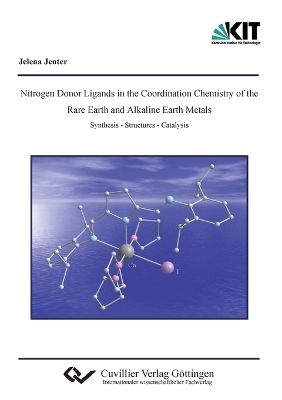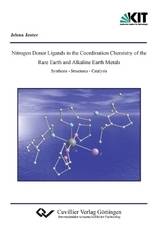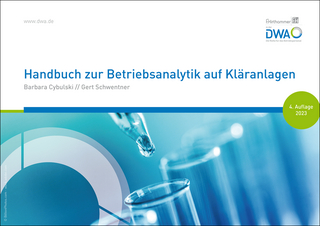Nitrogen Donor Ligands in the Coordination Chemistry of the Rare Earth and Alkaline Earth Metals
Synthesis - Structures - Catalysis
Seiten
2010
|
1., Aufl.
Cuvillier, E (Verlag)
978-3-86955-342-9 (ISBN)
Cuvillier, E (Verlag)
978-3-86955-342-9 (ISBN)
- Titel ist leider vergriffen;
keine Neuauflage - Artikel merken
Die in Schema I dargestellten Bisborhydridokomplexe der Seltenerdmetalle mit dem Bis(phosphinimino)methanid-Liganden konnten ausgehend von [K{CH(PPh2NSiMe3)2}], in Salzmetathesereaktionen mit [Ln(BH4)3(THF)n] (Ln = Sc (n = 2); Ln = La, Nd, Lu (n = 3)), oder im Falle des Yttriums, durch die Reaktion von [{(Me3SiNPPh2)2CH}YCl2]2 mit NaBH4 synthetisiert werden. Die Borhydrido-Liganden der Komplexe 3, 4, 6 und 7 weisen einen
?3-Koordinationsmodus im Festkörper auf, wohingegen interessanterweise für den polymorphen Scandiumkomplex 5 zwei verschiedene Strukturen nachgewiesen werden konnten, in denen entweder beide Borhydridanionen ?3-koordiniert sind, oder ein Borhydrido-Ligand eine ?2-Koordination aufweist. Desweiteren erwiesen sich die Komplexe 3, 6 und 7 als aktive Katalysatoren für die Ringöffnungspolymerisation von e-Caprolacton, mit sehr hohen Selektivitäten bei 0 °C. Tatsächlich wurden bei dieser Temperatur die niedrigsten Werte für die Molekularmassenverteilung erreicht, die jemals in der Seltenerdmetallborhydrid-katalysierten Ringöffnungspolymerisation von e-Caprolacton beobachtet wurden.
In Zusammenarbeit mit N. Meyer wurden Borhydrido- und Chlorokomplexe der Seltenerdmetalle mit dem 2,5-bis{N-(2,6-diisopropylphenyl)iminomethyl}pyrrolyl-Liganden synthetisiert. Die Darstellung des dimeren Neodymkomplexes [(DIP2pyr)NdCl2(THF)]2 (12) erfolgte durch den Umsatz von [(DIP2pyr)K] (10) mit wasserfreiem Neodymtrichlorid (Schema II). Die Reaktion des Kaliumsalzes 10 mit [Ln(BH4)3(THF)n] (Ln = Sc (n = 2);
Ln = La, Nd, Lu (n = 3)) zeigte eine Abhängigkeit von den Ionenradien der Metallzentren. Während für die größeren Seltenerdmetalle Lanthan und Neodym die erwarteten Produkte [(DIP2pyr)Ln(BH4)2(THF)2] (Ln = La (13), Nd (14)) entstanden, fand bei den kleineren Seltenerdmetallen Scandium und Lutetium eine unerwartete Redoxreaktion eines Borhydridanions mit einer der beiden Imin-Funktionen des Liganden statt, die zu den Produkten [{DIP2pyr*-BH3}Ln(BH4)(THF)2] (Ln = Sc (15), Lu (16)) führte (Schema II). Desweiteren wurden die beiden Neodymkomplexe 12 und 14 zusammen mit verschiedenen Cokatalysatoren als Ziegler-Natta Systeme für die Polymerisation von 1,3-Butadien zu
Poly-cis-1,4-butadien eingesetzt. Mit 12 als Katalysator konnten sehr hohe Aktivitäten und gute Selektivitäten beobachtet werden.
Der 2,5-bis{N-(2,6-diisopropylphenyl)iminomethyl}pyrrolyl Ligand konnte erfolgreich in die Koordinationschemie der zweiwertigen Lanthanide und der Erdalkalimetalle eingeführt werden. Wie in Schema III dargestellt, erfolgte die Synthese der heteroleptischen Iodokomplexe [(DIP2pyr)LnI(THF)3] (Ln = Sm (19), Eu (20), Yb (21)) sowie [(DIP2pyr)MI(THF)n] (M = Ca (24), Sr (22) (n = 3); Ba (23) (n = 4)) durch Salzmetathesereaktionen von [(DIP2pyr)K] (10) mit entweder den wasserfreien Lanthaniddiodiden oder den analogen Erdalkalimetaldiiodiden. Überraschenderweise lagen alle Produkte 19-24, unabhängig von ihren Ionenradien, im Festkörper als Monomere vor. Die Koordinationssphere des jeweiligen Metallzentrums ist durch die zusätzliche Koordination von THF-Molekülen gesättigt, was ein sehr seltenes Strukturmotiv in der Koordinationschemie der größeren zweiwertigen Lanthanide und der Erdalkalimetalle darstellt. Zusätzlich interessant ist der unterschiedliche Koordinationsmodus des (DIP2pyr)--Liganden, der in der Festkörperstruktur der Calciumverbindung 24 eine ?2-Koordination aufweist, während die übrigen Komplexe 19-23 ?3-koordiniert vorliegen (Schema III). Dies ist besonders ungewöhnlich, da Calcium und Ytterbium normalerweise dazu neigen, isostrukturelle Verbindungen zu bilden.
Um katalytisch aktive Spezies zu erhalten, wurden die Iodokomplexe [(DIP2pyr)MI(THF)3] (M = Ca (24), Sr (22)) mit [K{N(SiMe3)2}] umgesetzt (Schema IV) und die so erhaltenen Produkte [(DIP2pyr)M{N(SiMe3)2}(THF)2] (M = Ca (25), Sr (26)) hinsichtlich ihrer Aktivität in der intramolekularen Hydroaminierung von Aminoalkenen und einem Aminoalkin untersucht. Unglücklicherweise erwies sich der Anwendungsbereich der Katalysatoren 25 und 26 als eingeschränkt, da unerwünschte Nebenreaktionen in Form von Alken-Isomerisierung und Imin-Enamin-Tautomerisierung auftraten. Trotzdem zeigten beide Verbindungen hohe Aktivitäten und Ausbeuten, wobei sich der Calciumkomplex 25 als der reaktivere erwies, der hinsichtlich seiner Aktivität durchaus mit dem ß-Diketiminatocalciumkomplex [{(DIPNC(Me))2CH}Ca{N(SiMe3)2}(THF)] vergleichbar ist.
Weiterhin wurden Seltenerdmetallalkylkomplexe zweier Imidazolin-2-imid-Derivate von M. Tamm et al. synthetisiert, die im Rahmen der vorliegenden Arbeit als Katalysatoren in Hydroaminierungsreaktionen untersucht wurden. Beide Verbindungen erwiesen sich als katalytisch sehr aktiv und selektiv in der intramolekularen Hydroaminierung von Aminoalkenen und einem Aminoalkin. Obwohl sie nicht mit analogen Metallocenen konkurrieren können, sind sie dennoch neuartige katalytisch aktive Postmetallocene.
Description
Bis(phosphinimino)methanide rare earth metal bisborohydrides, as illustrated in Scheme I, were successfully synthesized by salt metathesis reactions of [K{CH(PPh2NSiMe3)2}] with [Ln(BH4)3(THF)n] (Ln = Sc (n = 2); Ln = La, Nd, Lu (n = 3)) or in the case of yttrium by the reaction of [{(Me3SiNPPh2)2CH}YCl2]2 with NaBH4. Interestingly, the BH4- anions are
?3-coordinated in the solid state structures of 3, 4, 6 and 7, while for the scandium complex 5 two different conformational polymorphs were identified, in which either both BH4- groups are ?3-coordinated or one BH4- anion shows an ?2-coordination mode. Furthermore, complexes 3, 6 and 7 showed high activities in the ring-opening polymerization (ROP) of
e-caprolactone (CL). At 0 °C, the molar mass distribution reached the narrowest values ever obtained for the ROP of CL initiated by a rare earth metal borohydride species.
In collaboration with N. Meyer, rare earth metal chlorides and borohydrides of the
2,5-bis{N-(2,6-diisopropylphenyl)iminomethyl}pyrrolyl ligand were synthesized, as shown in Scheme II. The reaction of [(DIP2pyr)K] (10) with anhydrous neodymium trichloride afforded [(DIP2pyr)NdCl2(THF)]2 (12) which is dimeric in the solid state. Excitingly, the reaction of [(DIP2pyr)K] (10) with [Ln(BH4)3(THF)n] (Ln = Sc (n = 2); Ln = La, Nd, Lu (n = 3)) depends on the ionic radii of the center metals. For the larger rare earth metals lanthanum and neodymium, the expected products [(DIP2pyr)Ln(BH4)2(THF)2] (Ln = La (13), Nd (14)) were obtained; while for the smaller rare earth metals scandium and lutetium, an unusual redox reaction of a BH4- anion with one of the Schiff-base functions of the ligand was observed and the products [{DIP2pyr*-BH3}Ln(BH4)(THF)2] (Ln = Sc (15), Lu (16)) were formed
(Scheme II). Moreover, the two neodymium containing complexes 12 and 14 were investigated as Ziegler-Natta catalysts for the polymerization of 1,3-butadiene to form
poly-cis-1,4-butadiene, by using various cocatalyst mixtures. Very high activities and good selectivities were observed for 12.
The 2,5-bis{N-(2,6-diisopropylphenyl)iminomethyl}pyrrolyl ligand was successfully introduced into the coordination chemistry of the divalent lanthanides and the alkaline earth metals. As shown in Scheme III, salt metathesis reactions of [(DIP2pyr)K] (10) with either anhydrous lanthanide diiodides or alkaline earth metal diiodides afforded the corresponding heteroleptic iodo complexes [(DIP2pyr)LnI(THF)3] (Ln = Sm (19), Eu (20), Yb (21)) or [(DIP2pyr)MI(THF)n] (M = Ca (24), Sr (22) (n = 3); Ba (23) (n = 4)). Surprisingly, all complexes 19-24 are monomeric in the solid state, independently from the ionic radii of their center metals. Instead of forming dimers, the coordination sphere of each metal center is satisfied by additionally coordinated THF molecules, which is a very rare structural motif in the chemistry of the larger divalent lanthanides and alkaline earth metals. While the (DIP2pyr)- ligands in 19-23 are ?3-coordinated in the solid state, for the calcium complex 24 an ?2-coordination mode was observed (Scheme III). Interestingly, the calcium complex 24 and the analogous ytterbium compound 21 show different structures in the solid state.
In order to obtain catalytically active species, [(DIP2pyr)M{N(SiMe3)2}(THF)2] (M = Ca (25), Sr (26)) were prepared by the reaction of [(DIP2pyr)MI(THF)3] (M = Ca (24), Sr (22)) with [K{N(SiMe3)2}] (Scheme IV). Compounds 25 and 26 were investigated for the intramolecular hydroamination of aminoalkenes and one aminoalkyne. Unfortunately, both catalysts exhibit a limited reaction scope, caused by the formation of undesired side products by alkene isomerization and imine-enamine tautomerism. However, both compounds are active catalysts and show high yields and short reaction times. The highest activities were observed for the calcium complex 25 and can be compared to the results obtained with the
ß-diketiminato calcium amide [{(DIPNC(Me))2CH}Ca{N(SiMe3)2}(THF)] as a catalyst.
Finally, imidazolin-2-imide and cyclopentadienyl-imidazolin-2-imine rare earth metal alkyl complexes, synthesized by M. Tamm et al., were investigated for the intramolecular hydroamination of non-activated aminoalkenes and one aminoalkyne. Both compounds showed high selectivities and activities, and although they cannot compete with the metallocene analogues, the imidazolin-2-imide complexes are new and interesting examples for catalytically active post-metallocenes.
?3-Koordinationsmodus im Festkörper auf, wohingegen interessanterweise für den polymorphen Scandiumkomplex 5 zwei verschiedene Strukturen nachgewiesen werden konnten, in denen entweder beide Borhydridanionen ?3-koordiniert sind, oder ein Borhydrido-Ligand eine ?2-Koordination aufweist. Desweiteren erwiesen sich die Komplexe 3, 6 und 7 als aktive Katalysatoren für die Ringöffnungspolymerisation von e-Caprolacton, mit sehr hohen Selektivitäten bei 0 °C. Tatsächlich wurden bei dieser Temperatur die niedrigsten Werte für die Molekularmassenverteilung erreicht, die jemals in der Seltenerdmetallborhydrid-katalysierten Ringöffnungspolymerisation von e-Caprolacton beobachtet wurden.
In Zusammenarbeit mit N. Meyer wurden Borhydrido- und Chlorokomplexe der Seltenerdmetalle mit dem 2,5-bis{N-(2,6-diisopropylphenyl)iminomethyl}pyrrolyl-Liganden synthetisiert. Die Darstellung des dimeren Neodymkomplexes [(DIP2pyr)NdCl2(THF)]2 (12) erfolgte durch den Umsatz von [(DIP2pyr)K] (10) mit wasserfreiem Neodymtrichlorid (Schema II). Die Reaktion des Kaliumsalzes 10 mit [Ln(BH4)3(THF)n] (Ln = Sc (n = 2);
Ln = La, Nd, Lu (n = 3)) zeigte eine Abhängigkeit von den Ionenradien der Metallzentren. Während für die größeren Seltenerdmetalle Lanthan und Neodym die erwarteten Produkte [(DIP2pyr)Ln(BH4)2(THF)2] (Ln = La (13), Nd (14)) entstanden, fand bei den kleineren Seltenerdmetallen Scandium und Lutetium eine unerwartete Redoxreaktion eines Borhydridanions mit einer der beiden Imin-Funktionen des Liganden statt, die zu den Produkten [{DIP2pyr*-BH3}Ln(BH4)(THF)2] (Ln = Sc (15), Lu (16)) führte (Schema II). Desweiteren wurden die beiden Neodymkomplexe 12 und 14 zusammen mit verschiedenen Cokatalysatoren als Ziegler-Natta Systeme für die Polymerisation von 1,3-Butadien zu
Poly-cis-1,4-butadien eingesetzt. Mit 12 als Katalysator konnten sehr hohe Aktivitäten und gute Selektivitäten beobachtet werden.
Der 2,5-bis{N-(2,6-diisopropylphenyl)iminomethyl}pyrrolyl Ligand konnte erfolgreich in die Koordinationschemie der zweiwertigen Lanthanide und der Erdalkalimetalle eingeführt werden. Wie in Schema III dargestellt, erfolgte die Synthese der heteroleptischen Iodokomplexe [(DIP2pyr)LnI(THF)3] (Ln = Sm (19), Eu (20), Yb (21)) sowie [(DIP2pyr)MI(THF)n] (M = Ca (24), Sr (22) (n = 3); Ba (23) (n = 4)) durch Salzmetathesereaktionen von [(DIP2pyr)K] (10) mit entweder den wasserfreien Lanthaniddiodiden oder den analogen Erdalkalimetaldiiodiden. Überraschenderweise lagen alle Produkte 19-24, unabhängig von ihren Ionenradien, im Festkörper als Monomere vor. Die Koordinationssphere des jeweiligen Metallzentrums ist durch die zusätzliche Koordination von THF-Molekülen gesättigt, was ein sehr seltenes Strukturmotiv in der Koordinationschemie der größeren zweiwertigen Lanthanide und der Erdalkalimetalle darstellt. Zusätzlich interessant ist der unterschiedliche Koordinationsmodus des (DIP2pyr)--Liganden, der in der Festkörperstruktur der Calciumverbindung 24 eine ?2-Koordination aufweist, während die übrigen Komplexe 19-23 ?3-koordiniert vorliegen (Schema III). Dies ist besonders ungewöhnlich, da Calcium und Ytterbium normalerweise dazu neigen, isostrukturelle Verbindungen zu bilden.
Um katalytisch aktive Spezies zu erhalten, wurden die Iodokomplexe [(DIP2pyr)MI(THF)3] (M = Ca (24), Sr (22)) mit [K{N(SiMe3)2}] umgesetzt (Schema IV) und die so erhaltenen Produkte [(DIP2pyr)M{N(SiMe3)2}(THF)2] (M = Ca (25), Sr (26)) hinsichtlich ihrer Aktivität in der intramolekularen Hydroaminierung von Aminoalkenen und einem Aminoalkin untersucht. Unglücklicherweise erwies sich der Anwendungsbereich der Katalysatoren 25 und 26 als eingeschränkt, da unerwünschte Nebenreaktionen in Form von Alken-Isomerisierung und Imin-Enamin-Tautomerisierung auftraten. Trotzdem zeigten beide Verbindungen hohe Aktivitäten und Ausbeuten, wobei sich der Calciumkomplex 25 als der reaktivere erwies, der hinsichtlich seiner Aktivität durchaus mit dem ß-Diketiminatocalciumkomplex [{(DIPNC(Me))2CH}Ca{N(SiMe3)2}(THF)] vergleichbar ist.
Weiterhin wurden Seltenerdmetallalkylkomplexe zweier Imidazolin-2-imid-Derivate von M. Tamm et al. synthetisiert, die im Rahmen der vorliegenden Arbeit als Katalysatoren in Hydroaminierungsreaktionen untersucht wurden. Beide Verbindungen erwiesen sich als katalytisch sehr aktiv und selektiv in der intramolekularen Hydroaminierung von Aminoalkenen und einem Aminoalkin. Obwohl sie nicht mit analogen Metallocenen konkurrieren können, sind sie dennoch neuartige katalytisch aktive Postmetallocene.
Description
Bis(phosphinimino)methanide rare earth metal bisborohydrides, as illustrated in Scheme I, were successfully synthesized by salt metathesis reactions of [K{CH(PPh2NSiMe3)2}] with [Ln(BH4)3(THF)n] (Ln = Sc (n = 2); Ln = La, Nd, Lu (n = 3)) or in the case of yttrium by the reaction of [{(Me3SiNPPh2)2CH}YCl2]2 with NaBH4. Interestingly, the BH4- anions are
?3-coordinated in the solid state structures of 3, 4, 6 and 7, while for the scandium complex 5 two different conformational polymorphs were identified, in which either both BH4- groups are ?3-coordinated or one BH4- anion shows an ?2-coordination mode. Furthermore, complexes 3, 6 and 7 showed high activities in the ring-opening polymerization (ROP) of
e-caprolactone (CL). At 0 °C, the molar mass distribution reached the narrowest values ever obtained for the ROP of CL initiated by a rare earth metal borohydride species.
In collaboration with N. Meyer, rare earth metal chlorides and borohydrides of the
2,5-bis{N-(2,6-diisopropylphenyl)iminomethyl}pyrrolyl ligand were synthesized, as shown in Scheme II. The reaction of [(DIP2pyr)K] (10) with anhydrous neodymium trichloride afforded [(DIP2pyr)NdCl2(THF)]2 (12) which is dimeric in the solid state. Excitingly, the reaction of [(DIP2pyr)K] (10) with [Ln(BH4)3(THF)n] (Ln = Sc (n = 2); Ln = La, Nd, Lu (n = 3)) depends on the ionic radii of the center metals. For the larger rare earth metals lanthanum and neodymium, the expected products [(DIP2pyr)Ln(BH4)2(THF)2] (Ln = La (13), Nd (14)) were obtained; while for the smaller rare earth metals scandium and lutetium, an unusual redox reaction of a BH4- anion with one of the Schiff-base functions of the ligand was observed and the products [{DIP2pyr*-BH3}Ln(BH4)(THF)2] (Ln = Sc (15), Lu (16)) were formed
(Scheme II). Moreover, the two neodymium containing complexes 12 and 14 were investigated as Ziegler-Natta catalysts for the polymerization of 1,3-butadiene to form
poly-cis-1,4-butadiene, by using various cocatalyst mixtures. Very high activities and good selectivities were observed for 12.
The 2,5-bis{N-(2,6-diisopropylphenyl)iminomethyl}pyrrolyl ligand was successfully introduced into the coordination chemistry of the divalent lanthanides and the alkaline earth metals. As shown in Scheme III, salt metathesis reactions of [(DIP2pyr)K] (10) with either anhydrous lanthanide diiodides or alkaline earth metal diiodides afforded the corresponding heteroleptic iodo complexes [(DIP2pyr)LnI(THF)3] (Ln = Sm (19), Eu (20), Yb (21)) or [(DIP2pyr)MI(THF)n] (M = Ca (24), Sr (22) (n = 3); Ba (23) (n = 4)). Surprisingly, all complexes 19-24 are monomeric in the solid state, independently from the ionic radii of their center metals. Instead of forming dimers, the coordination sphere of each metal center is satisfied by additionally coordinated THF molecules, which is a very rare structural motif in the chemistry of the larger divalent lanthanides and alkaline earth metals. While the (DIP2pyr)- ligands in 19-23 are ?3-coordinated in the solid state, for the calcium complex 24 an ?2-coordination mode was observed (Scheme III). Interestingly, the calcium complex 24 and the analogous ytterbium compound 21 show different structures in the solid state.
In order to obtain catalytically active species, [(DIP2pyr)M{N(SiMe3)2}(THF)2] (M = Ca (25), Sr (26)) were prepared by the reaction of [(DIP2pyr)MI(THF)3] (M = Ca (24), Sr (22)) with [K{N(SiMe3)2}] (Scheme IV). Compounds 25 and 26 were investigated for the intramolecular hydroamination of aminoalkenes and one aminoalkyne. Unfortunately, both catalysts exhibit a limited reaction scope, caused by the formation of undesired side products by alkene isomerization and imine-enamine tautomerism. However, both compounds are active catalysts and show high yields and short reaction times. The highest activities were observed for the calcium complex 25 and can be compared to the results obtained with the
ß-diketiminato calcium amide [{(DIPNC(Me))2CH}Ca{N(SiMe3)2}(THF)] as a catalyst.
Finally, imidazolin-2-imide and cyclopentadienyl-imidazolin-2-imine rare earth metal alkyl complexes, synthesized by M. Tamm et al., were investigated for the intramolecular hydroamination of non-activated aminoalkenes and one aminoalkyne. Both compounds showed high selectivities and activities, and although they cannot compete with the metallocene analogues, the imidazolin-2-imide complexes are new and interesting examples for catalytically active post-metallocenes.
| Sprache | englisch |
|---|---|
| Einbandart | kartoniert |
| Themenwelt | Naturwissenschaften ► Chemie |
| Schlagworte | Hardcover, Softcover / Chemie |
| ISBN-10 | 3-86955-342-1 / 3869553421 |
| ISBN-13 | 978-3-86955-342-9 / 9783869553429 |
| Zustand | Neuware |
| Haben Sie eine Frage zum Produkt? |
Mehr entdecken
aus dem Bereich
aus dem Bereich
Buch (2024)
Deutsche Vereinigung für Wasserwirtschaft, Abwasser und … (Verlag)
52,00 €




